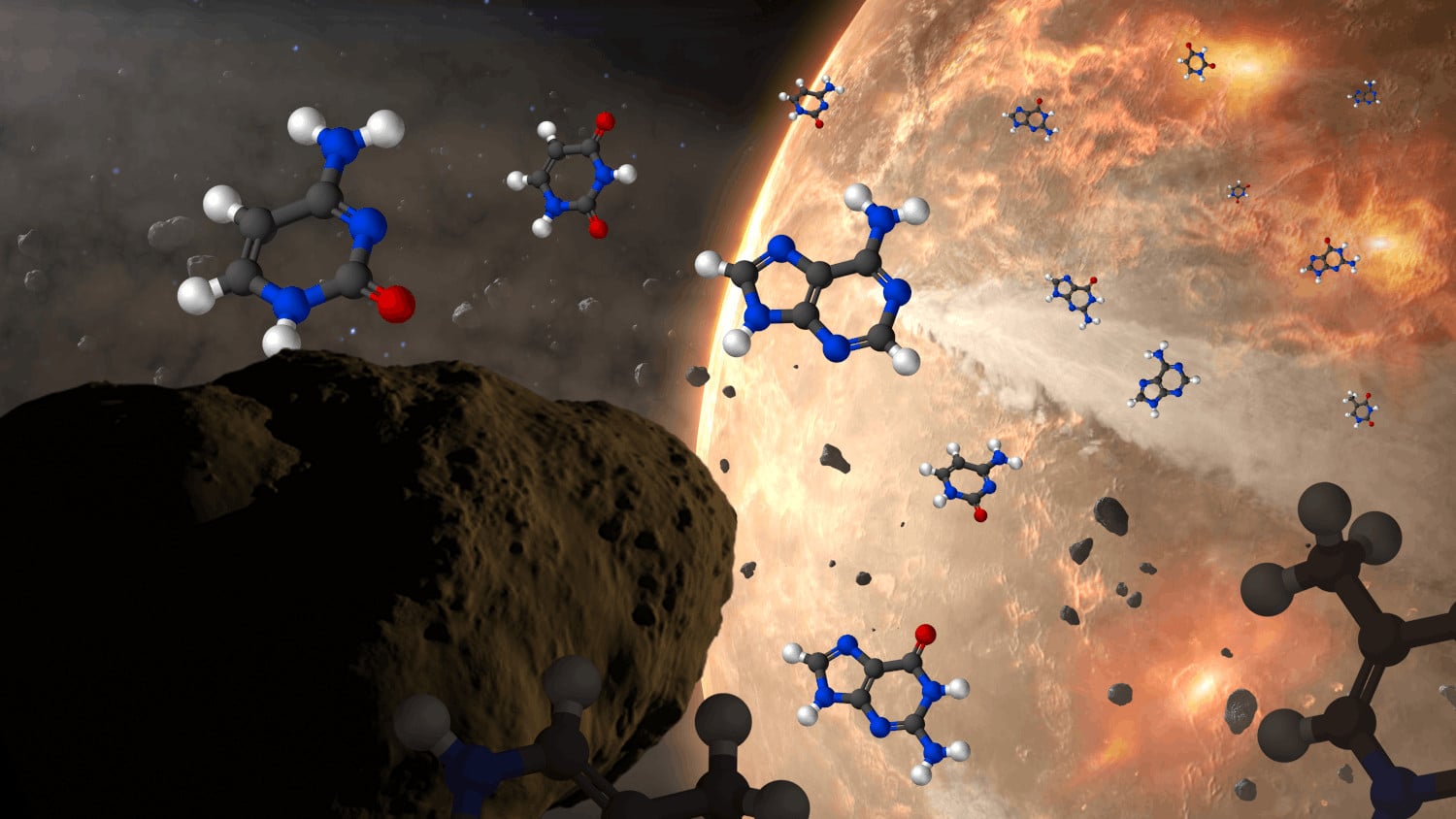Our DNA and RNA are made up of five nitrogenous bases, which play a major role in the expression and transmission of genetic information. Besides sugars (nucleosides) or phosphates (nucleotides), they are also involved in many metabolic processes. Researchers now claim that these bases – adenine, cytosine, guanine, thymine and uracil – were all found in meteorite fragments. This discovery suggests that the first signs of life on Earth may have originated in space.
Recent sample return missions from the Ryugu (C-type) and Benu (B-type) asteroids, led by JAXA and NASA respectively, will provide important information on extraterrestrial organic molecules and potential clues regarding the origins of life on Earth. In fact, these carbon-rich asteroids are plausible parent bodies for meteorites on Earth, where many primitive organic molecules were discovered in the early 1960s—including adenine and guanine, as well as traces of uracil.
Using a new analysis technique that can more gently extract and separate different chemical compounds from liquefied meteorite dust, a team of Japanese researchers, including two members of NASA’s Solar System Exploration Division, examined three carbonaceous meteorites that fell decades ago — including the Murchison meteorite, which fell in 1969 in Australia, is famous for the many organic compounds it contains (including amino acids, purines and pyrimidines). Their technique revealed the presence of all five nuclear bases in all samples.
Nuclear bases and other compounds essential to life
The origins of life on Earth are still debated: Are the primordial molecules the result of chemical processes that occurred on Earth in a “prebiotic soup” or did they come from space? The new study was published in Nature Communications Leaning in favor of the second hypothesis: A variety of exogenous organic matter of meteorite origin, including nuclear bases, may have been delivered to early Earth during the Late Heavy Bombardment period (about 4.0-3.8 billion years ago) Write researchers.
In this study, the team analyzed meteorites from Murchison (two samples), Murray (fallen in 1950 in Kentucky), and Tagish Lake (fall of 2000 in Canada) by means of high-performance liquid chromatography paired with a high-resolution electrospray ionization mass sensor.
” Our detection method has a sensitivity several orders of magnitude higher than that applied in previous studies. “,” he said to science news Yasuhiro Oba, a geochemist at Hokkaido University, who led the study. Their goal was to measure the abundance of nitrogen-containing heterocyclic particles in each of these meteorites. Their extraction technology uses cold water instead of the typically hot formic acid, which preserves these particularly fragile compounds.
That is, there are two types of nucleobases in DNA and RNA: pyrimidine nucleobases, consisting of one heterocyclic nitrogen ring with six atoms (cytosine, uracil and thymine), and purine bases, consisting of two rings with six and five atoms (adenine and guanine). . So far, only thymine and cytosine have been missing from the meteorite analyses.
Several purine nuclear bases have been identified in the two Murchison-Guanine meteorite samples that are generally the most abundant of all meteorites (except those in Tagish Lake). Various purine and pyrimidine molecules were also identified in the Tagish and Murray samples. Finally, the researchers discovered and measured in the four samples the five nitrogenous bases, as well as many compounds related to these bases and some amino acids. They then proceeded to perform the same analyzes on the Earth where the meteorites were captured.
Ground soil contamination is unlikely
For some of the detected compounds, the abundance values of meteorites were higher than those in the surrounding soil, indicating that the compounds did indeed arrive on Earth and were transported by these rocks. On the other hand, for other compounds, notably cytosine and uracil, the abundance measured in soil is up to 20 times higher than for meteorites.
These results indicate that these compounds may have been deposited in meteorites via terrestrial pollution. For cosmologist Michael Callahan of Boise State University in Idaho, who was not involved in this study, the data are not convincing enough to confirm that nuclear bases are of extraterrestrial origin.
However, Oba and colleagues note that they have identified other compounds that support their hypothesis. In fact, they discovered more than a dozen other compounds essential for life in meteorites, in particular the five bases isomers. However, these isomers – compounds with the same chemical formula, but whose atoms are organized differently – are found only in meteorites, not in the surrounding soil, which rules out the possibility of soil contamination.
Studying meteorites “from their source” will make it possible to definitively remove doubt, which is why the team is currently applying its method of analysis to samples from the Ryugu asteroid, which the Hayabusa mission returned to Earth in December 2020. .2; Samples from asteroid Bénou are scheduled to be returned as part of the OSIRIS-Rex mission in September 2023. Scientists are excited about the new clues this extraterrestrial material will bring. If the molecules that make up DNA do indeed come from outer space, that calls into question the possible distribution of life in our solar system and beyond.
source : Y. Oba et al., Nature Communications

“Proud thinker. Tv fanatic. Communicator. Evil student. Food junkie. Passionate coffee geek. Award-winning alcohol advocate.”

